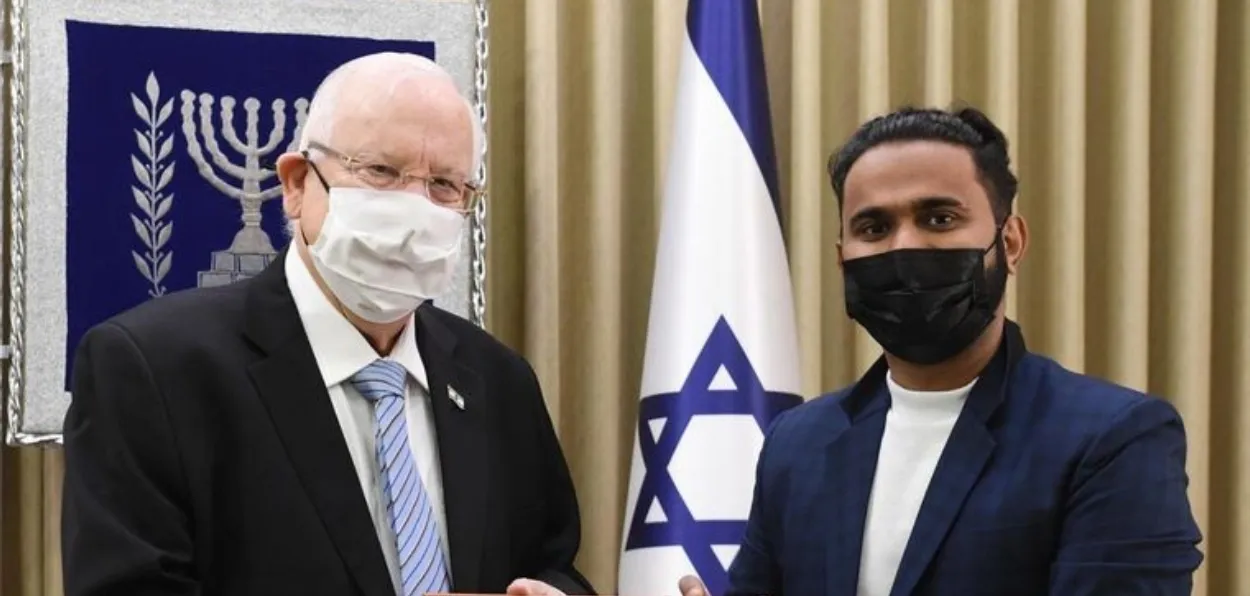
Abdur Rauf Toti/Kochi
On a Saturday evening 25 years ago, the 10-year-old Thoufeek Zakriya walked into the Jewish street of Mattancherry in Kochi, Kerala. He was holding his father's hand. Zakriya had been to many streets in the city, but none was as beautiful as this one. Its yellow lights, old buildings, antique shops, and the aroma of spices being sold in the shops created an emchanting atmosphere.
At the end of the street is the Peridesi Synagogue, built in 1568 and rebuilt over the following centuries. In Malayalam, Pardesi means foreigner; the synagogue served several generations of Sephardic Jews who migrated to Kochi from Spain, Portugal, and West Asia. However, Zakriya, a ,Madrasa student was not piqued by the stories of exiled Jews, but by the hordes of tourists who were entering the synagogue in silence.
When Zakriya and his father arrived at the synagogue, the doorman said it was closed for the day. His father pleaded with the doorman to let them in since his son had a strong desire to see the synagogue. Hearing this conversation, a Jewish man who wore a kippah (Jewish hat) was lighting a lamp inside, came out and led them inside, smiling. The young Zakriya saw graffiti in Hebrew and a finely carved Torah inside. By now the kind man who had facilitated his entry, had resumed his work.
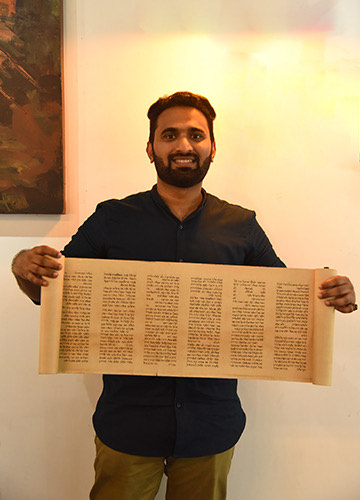 Thoufeek Zakriya with one of his calligraphy works in Hebrew
Thoufeek Zakriya with one of his calligraphy works in Hebrew
Zakriya approached him, and the man said he was lighting a lamp to commemorate a relative's anniversary.
Walking down memory lane, Zakriya, 35, says that if he closes his eyes, he visualizes he in the Synagogue on that day. The visit to Sunagogue turned out to be the life changing moment for this young Muslim boy.
Thoufeek Zakriya is today an internationally renowned calligrapher in Hebrew, Arabic, and Armenic and a researcher of Cochin Jewish history. He learned Hebrew, a difficult language.
Zakriya, lives in Dubai. In 2020, he presented one of his calligraphy works to Israeli President Reuven Rivlin.
Learning new languages and practicing calligraphy became Zakriya ‘s passion right from his school days.Growing up in the culturally compatible neighborhoods of Fort Kochi and Matancherry helped him hone his interests. By the time he was in the 10th grade, he had developed a set of Chinese-like characters to communicate with his friends secretly.
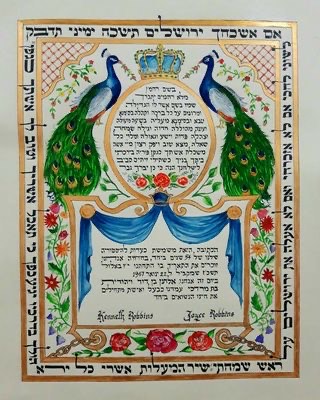 A Torah designed in Indian motif by Thoufeek Zakriya
A Torah designed in Indian motif by Thoufeek Zakriya
It was his exposure to Arabic at the seminary that sparked his interest in Hebrew. "In the seminary, I learned the basics of Arabic to read the Qur'an, and heard many stories about the prophets Ibrahim, Ishmael and Isaac," Zakriya says.
"Later, at the convent school where I studied, I learned the biblical stories of Abraham, Isaac and Ishmael," says Zakriya. "How the story of the same elders can be from different angles fascinated me. It was then that I became curious about the third perspective, or the first perspective, the Jewish perspective. I asked people about the Jewish community in Cochin, about which I knew very little. Soon I heard about Hebrew, their special language, similar to Arabic, written from right to left.
It was a Gideon Bible from which he learned Hebrew. Zakriya said that when I was in class 11, he first saw a Gideon Bible in the school library. "I asked my teacher if I could borrow it, and he happily gave it to me. The preface contained a verse from the book of John in 25 different languages, including Hebrew. The English version had the word God for God."
He says, "I wanted to know the Hebrew word for God—that started my journey of learning Hebrew." Zakriya began by copying the Hebrew letters. "I was practicing calligraphy, although I didn't know it was an art form. I used pen, fiber, and bamboo wood to copy the text."
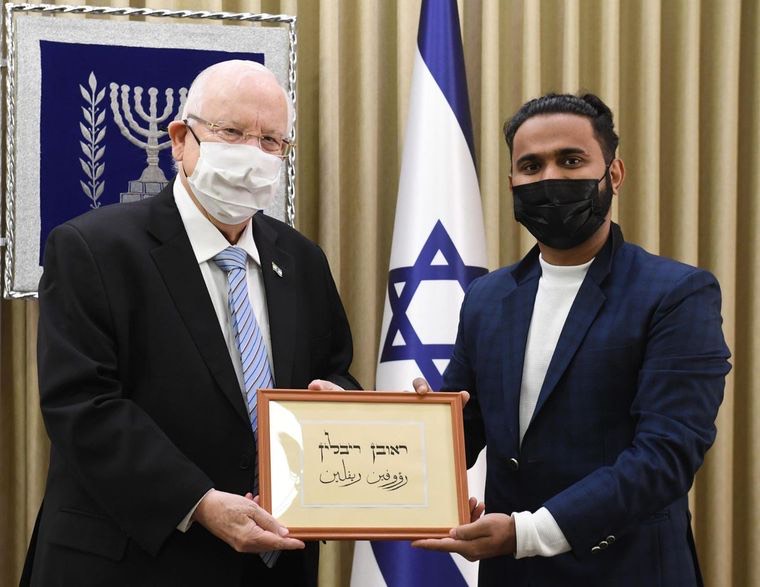
Thoufeek Zakriya Presenting a Calligraphic writting in Hebrew to Israeli President
He says that in a shop that sold second-hand books, he found a volume with Hebrew on one side and English on the other. I couldn't read Hebrew, but there was a prayer called the Kaddish at the end with a transliteration in English.
He gradually improved his skills till there came a turning point in his life. My friends and I used to spend time in the synagogue, just enjoying the atmosphere. One day a group of people, including the wife of an election commissioner, came to visit. Community leader Joseph Haligua was also with him. He opened the altar, the Hechel, and showed the Torah. Someone in the group said that the Torah appeared upside down.
Zakriya knew that the Hebrew script could sometimes give such an impression, so he said: No, no, it is correct. The answer was quite loud. Haligua looked at them and asked how they knew. Zakriya replied that he had learned Hebrew.
As the people left, Haligua asked Zakriya more about his interest in Jewish culture. Joy, the caretaker of the synagogue, suggested that they talk to Haligua's brother Samuel, who is a "walking encyclopedia" on the history of Cochin Jews and the synagogue's Gabai (warden).
Thus began Zakriya’s formal learning of Jewish history. However, he paid a price for his interest as he failed his 12 class examinations."
Zakriya was depressed but he started learning Hebrew and Arabic more diligently. "I used my old notebooks to practice my calligraphy," he said. I also became familiar with Samaritan, Syriac, Aramaic, Coptic, and Greek. What I learned in that one year was not in any syllabus. I was a teacher, student and principal of my institution."
He graduated in Hotel Management, as his family was involved in the food business. He said his father and grandfather were in seafood export. On his mother's side, my great-grandfather owned a burma (brick oven bakery) and was popularly known as Biskatkaran Masaliar for selling biscuits and being a learned Muslim priest.
Another reason for studying hotel management was that his father's business was slowing down. "I was a decent cook then," says Zakriya. "I referred to old recipes and practiced cooking. After tasting my biryani, my father decided to send me to hotel management school. An Indian-style ketubah (marriage contract) is made for a US-based guardian."
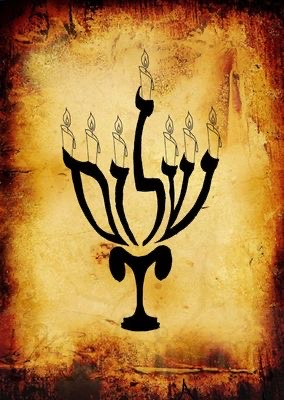
One of Thoufeek Zakriya's work
For the final year project of his four-year course, he focused on Jewish culinary traditions. He also continued calligraphy. In 2009, Zakaria took a friend to Kochi's Jewish quarter. He came up with ten different designs for Barakat Habitat - a Jewish prayer often written on wall plaques and displayed on the doors of Jewish homes. At his friend's request, Zakriya showed it to Sarah Cohen, a respected woman in the Jewish community in Kochi. Cohen was shocked.
"She was quite surprised to see a Muslim writing Hebrew," recalls Zakriya. He repeatedly asked me, are you Jewish? And I told him, no, I am a Muslim. Thus Barakat Habayit's plaque began a ten-year friendship that lasted until 2019, when Cohen died at the age of 96. She used to call me Aashna (Malayalam for Master); she was like a grandmother to me. Whenever I would visit, I would bring her favorite snacks, achapam and kajhalpam. Cohen hosted Zakriya for Passover Seders and introduced him to members of the dwindling Jewish community.
"One day, she took me to the synagogue when worship was about to begin," he said. Almost the entire Jewish community was present in Kochi. She took me and my family inside to show us the synagogue in all its glory. That said, this may be the last time the synagogue is properly decorated. Maybe I won't be able to show you next time. No one in the community said a word about bringing non-Jews into the synagogue during the service. It was the respect,"
After developing his unique calligraphy style, Zakaria started accepting requests from people abroad. Among his early patrons was a Ukrainian millionaire who presented him with a challenge. He wanted a Hebrew scripture to be written in the Arabic style.
"The ancient Kufi Arabic script was a unique calligraphic work," says Zakriya. Zakriya says his most "emotional" work ever was for Juliet Halegua, wife of Joseph Halegua, who died in 2012.
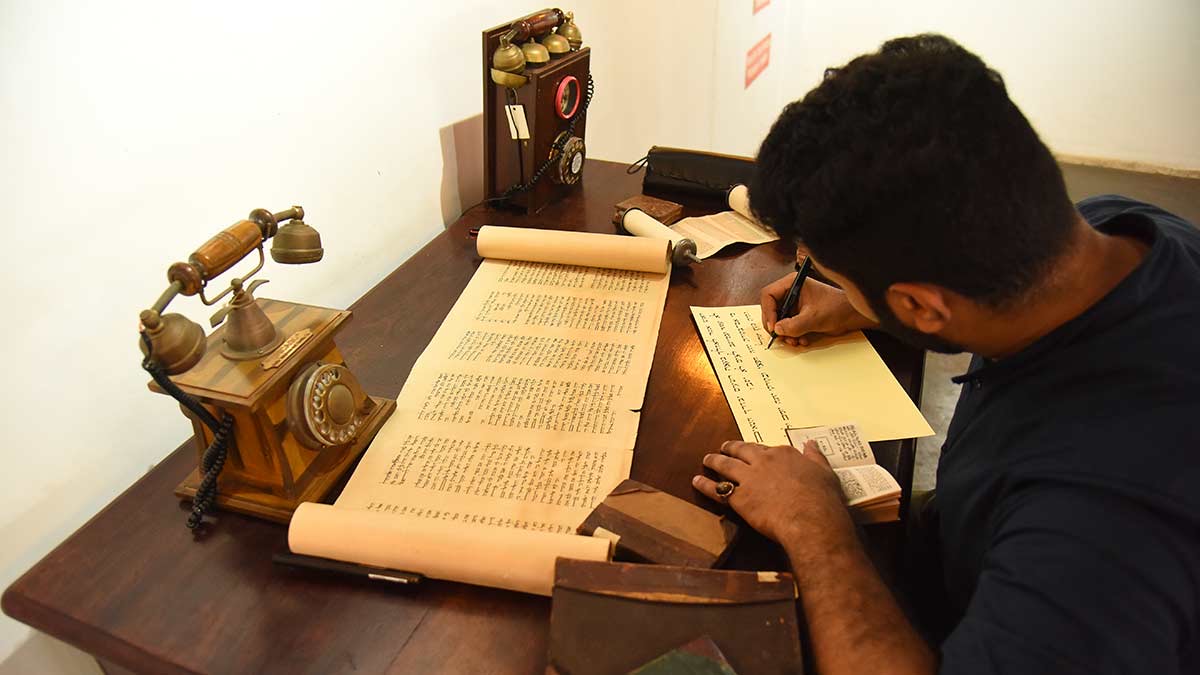
Thoufeek Zakriya writing in Hebrew
"They asked me to design his tombstone, and I did. As a tribute, he allowed me to examine a centuries-old Jewish copper plate (a specimen engraved with privileges granted to the Jewish community by the local rulers of Kerala)".
Over the past decades, most of Kerala's Jews have immigrated to Israel, and Zakriya has become a keeper and historian of Jewish memorabilia and artifacts. When an ancient tomb with Hebrew inscriptions was discovered on a coconut farm in Ramanathapuram, Tamil Nadu, Zakriya was called.
He was the first person to understand these inscriptions, which were dated around 1225 AD. This means it is older than the tomb of Sarah Bet Israel in Chandamangalam, Kerala, which is believed to be the oldest Hebrew tomb in India, says Zakriya.
Zakriya runs a blog and Facebook page called "Jews of Malabar". Coincidentally, it was a post on the page that led to his meeting with Revlon in 2020. This post was about the history of the 18th-century Hebrew Qur'an - the work of a leader of the Kochi Jewish community. Zacharias says. Yosef Joel Rivlin, father of President Rivlin, also translated the Koran into Hebrew.
"Someone tweeted this Qur'an (frontspace), which was different from all previous versions of Hebrew calligraphy I've seen. So I made a small copy of the design and posted it as a tribute. Rivlin saw this and wanted to meet me. Fortunately, a few weeks earlier, the UAE and Israel had established full diplomatic relations. It helped me on my trip to Israel."
ALSO READ: Taha Ibrahim of Kochi cherishes his bond with Jews
Zakriya faces questions regarding his stance on the Israel-Palestine conflict. He insists that he strongly supports universal brotherhood. "I believe that everyone in this world deserves to wake up to a bright and beautiful day, have a happy day, and sleep peacefully," he says. Without a doubt, he says, I stand with all those who suffer in this world. They all deserve peace.
